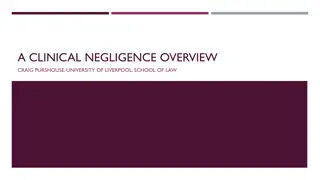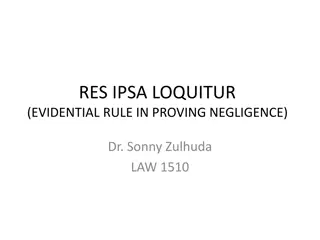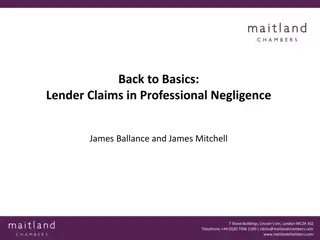Understanding Contributory Negligence in Legal Context
Contributory Negligence (CN) refers to negligence that materially contributes to an injury, not just a breach of duty. It involves a person failing to take reasonable care of themselves, leading to their own injury. Legal cases like Ong Ah Long v Dr. S. Underwood [1983] and Kek Kee Leng v Teresa Bong Nguk Chin [1978] illustrate the application of contributory negligence principles. The Civil Law Act 1956 provides provisions on the apportionment of liability in such cases.
Download Presentation

Please find below an Image/Link to download the presentation.
The content on the website is provided AS IS for your information and personal use only. It may not be sold, licensed, or shared on other websites without obtaining consent from the author. Download presentation by click this link. If you encounter any issues during the download, it is possible that the publisher has removed the file from their server.
E N D
Presentation Transcript
CONTRIBUTORY NEGLIGENCE Dr. Sonny Zulhuda
OUTLINE Definition Statutory Provision Elements Agony of the Moment C.N. by children
DEFINITION OF CONTRIBUTORY NEGLIGENCE CN is an expression which means negligence materially contributing to the injury Negligence here is not used in its usual meaning, not to mean a breach of duty Kek Kee Leng v Teresa Bong Nguk Chin [1978] D must show P did not, on his own interest, take reasonable care of himself and contributed by that want of care to his own injury. Ong Ah Long v Dr. S. Underwood [1983] Also defined in s. 12(1) Civil Law Act 1956
ONG AH LONG V DR. S. UNDERWOOD [1983] 2 MLJ 324 SYED AGIL BARAKBAH FJ that there is no question of contributory negligence on the part of the respondent, that the appellant was wholly to blame for failing to pay attention to the presence of other road users and in consequence thereof failed to allow sufficient space between his van to enable the respondent to pass safely. The learned Judge applied the correct test in that the appellant had failed to prove that the respondent did not take reasonable care of himself and contributed by that want of care to his own injury. The test for contributory negligence in the case of a pedestrian is not whether he is under a duty of care towards the defendant, but whether he was acting as a reasonable man and with reasonable care. the appellant of a van grazed against the respondent's left arm while he was walking beside his car in a street in Ipoh. App argued CN because Resp had raised his elbow prior to accident.
KEK KEE LENG V TERESA BONG NGUK CHIN [1978] 1 MLJ 61 D s car turned from a side road, which is the exit road from the new General Hospital in Kuching, into the main Jalan Tun Haji Openg along which P (the motor- scooterist) was approaching when the latter was only 60 feet from the junction, there could be no circumstances in which P could be held to be blamed, even partially, for the accident. The distance was too short for the P to stop D is an adult, licensed to drive and therefore presumably he has acquired a knowledge not only of the Highway Code but also of the ordinary precautions to be taken by him for his own safety as well as for the safety of others. If he obtrudes himself on to the main road in circumstances which make it impossible for traffic coming behind him to avoid a collision, then I do not think there can be any doubt as to his entire responsibility for the accident
S. 12(1) CIVIL LAW ACT 1956 ON APPORTIONMENT OF LIABILITY Where any person suffers damage as the result partly of his own fault and partly of the fault of any other person a claim in respect of that damage shall not be defeated by reason of the fault of the person suffering the damage but the damages recoverable in respect thereof shall be reduced to such extent as the Court thinks just and equitable having regard to the claimant s share in the responsibility for the damage
ELEMENTS OF CONTRIBUTORY NEGLIGENCE Two requirements: Foreseeability case of Jones v Livox Quarries Ltd [1952] CN requires the foreseeability of harm to oneself. A person is guilty of CN if he ought reasonably to have foreseen that, if he did not act as a reasonable, prudent man, he might be hurt himself; and he must take into account the possibility of others being careless. Causation section 12(1) CLA 1956
SOME CASES OF CONTRIBUTORY NEGLIGENCE Foo Kok Foo v Yap Hai Chwee [1972] 1 MLJ 153 P did CN for extending his left arm outside the window (Held 25-75%). Siti Rohani bte Mohd Shah v Haji Zainal bin Saifiee [2001] 5 MLJ 8 No CN even though the P rode motorcycle without a helmet and no valid license Low Kwan Moi v Ramli bin Jamil & Govt of Malaysia [1984] 1 MLJ 46 Police was liable for Negligence, but deceased also for CN for jumping into the river. (Held 25%-75%).
FOO KOK FOO V YAP HAI CHWEE [1972] 1 MLJ 153 Mohamed Azmi J: When traveling in a motor car along a road where traffic is heavy, whether as a driver or a passenger, a person ought to be conscious that it is extremely dangerous even to rest his arm on the door window with or without the elbow protruding. The various follies of road users in a city are so common nowadays that they ought to be foreseeable and a prudent man should, when traveling in such a place, keep both his hands well inside his vehicle.
AGONY IN THE MOMENT D cannot escape liability if the plaintiff, in the agony of the moment tries to save himself by choosing a course of conduct that proves to be the wrong one. P does not contribute CN if he acted in a reasonable apprehension of danger and the method by which he tried to avoid it was a reasonable one Case of Govinda Raju v. Laws [1966] Court: what was done or not done in the agony of the moment cannot be fairly treated as negligence. Case of Choh Nyee Ngah v Syarikat Beruntong S/B [1989] 3 MLJ 112 Deceased was not in CN for he was In the agony between remaining in the lorry driver s seat or jumping outside the lorry.
AGONY OF THE MOMENT: GOVINDA RAJU V LAWS [1966] 1 MLJ 188 D turns right at a junction while P on motorbike was oncoming from an opposite direction. P tried to avoid and swerved right but finally knocked the rear side of D s car. Court: D was negligent, what P did could not amount to a contributory negligence What was done or not done in the agony of the moment cannot be fairly treated as negligence When a plaintiff is perplexed or agitated when exposed to danger by the wrongful act of defendant, it is sufficient if he shows such judgment and control in attempting to avoid the accident as may reasonably be expected of him in the circumstances.
SYARIZAN BIN SUDIRMIN & ORS V ABDUL RAHMAN BIN BUKIT & ANOR [2010] 8 MLJ 530 VT Singham J: in attempting to escape apprehension in this police pursuit the first plaintiff took a serious risk to himself and other road users in riding his motorcycle at such fast speed. Therefore, this court finds the first plaintiff had also contributed to the damage he had suffered. Accordingly, the damages have to be reduced as this court finds having regard to the first plaintiff s share in the responsibility for the damage (see s 12(1) of the Civil Law Act 1956).
SYARIZAN BIN SUDIRMIN & ORS V ABDUL RAHMAN BIN BUKIT & ANOR [2010] 8 MLJ 530 VT Singham J: As for not wearing crash helmet, a reasonable prudent motorist in the position of the first plaintiff s position would have foreseen that the wearing of crash helmet might result is less harm or injury being caused to his head if he is involved in a collision.. Accordingly, there should be a deduction on the damages to be awarded for his head injury. Accordingly, liability should be apportioned at 75% against the first defendant and 25% contributory on the part of the first plaintiff for his want of reasonable care for his own safety and failure to wear a crash helmet that had contributed to his head injuries.
CN INVOLVING CHILDREN The court takes into account the age of the Plaintiff in considering whether he is liable for CN, depending on the circumstances. The standard of care of an older child is the degree of care that may reasonably be expected from a person in the plaintiff s situation. Lembaga Letrik Negara, Malaysia v. Ramakrishnan [1982] Court: the test is whether an ordinary child of the respondent s age and experience neither a paragon of prudence nor a scatterbrain would have taken any more than did the respondent.
REVISE! Define Contributory Negligence from both statutory and common law principles What does the word Negligence indicate here? How does the court determine the amount of contribution by the plaintiff? What is the test for plaintiff s act in agony of the moment? Can a child be liable of contributory negligence?




















![Understanding Negligence Liability in Donoghue v. Stevenson [1932]](/thumb/198881/understanding-negligence-liability-in-donoghue-v-stevenson-1932.jpg)


